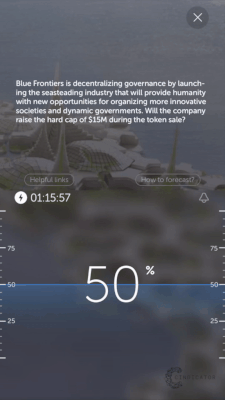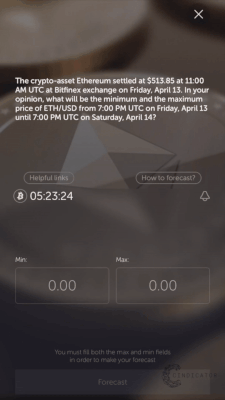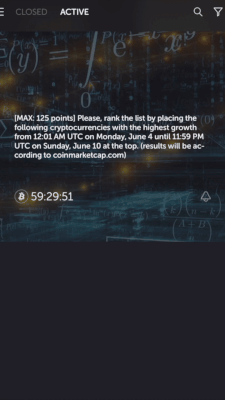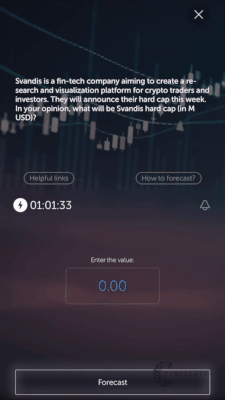How I Hacked My Way Into The Top 100 on Cindicator in Two Weeks
BY CRYSTAL STRANGER, CO-FOUNDER, PEACOUNTS ON 6/27/2018 AT 5:30AM

Cindicator Logo / Cindicator
I never thought I was good at judging short-term moves in the market. I typically can see clear as day what will happen in the long-term, but the timeline of when those moves will happen has always been a mystery. I've debated joining think tanks and the like, because I wonder why other people don't see long-term changes as well, but it wasn't until I signed up at Cindicator, a predictive analytics company that runs a competition for amateur forecasters, that I started actually making predictions. What I am great at though, is finding loopholes.
I started making predictions on Cindicator in Mid-January of 2018, and I reached place #71 out of nearly 100,000 participants by the end of January with 720 points in the crypto markets challenge, the competition for forecasting the moves in various cryptocurrencies, in less than two weeks. How did I do it? It wasn't very hard, I just gamed the averages and made predictions accordingly. Let me first talk about what Cindicator is, then I will explain the types of questions and how I worked this to my advantage.
Cindicator is the leader in prediction market companies. There are now over 100,000 users actively predicting events in the system. Predictive analytics, while far from sexy, is a good application of blockchain technology as the predictions are verified on blockchain so that people cannot change their record.
In exchange for making predictions, Cindicator splits a prize every month with their top analysts. Currently the prize is 1.25 Bitcoin for the crypto markets prize, and $7500 for the Traditional Markets Prize Fund. Payments when distributed are made in Ethereum; I earned 0.01438023 ETH in January.
Aggregating the predictions using a proprietary algorithm, Cindicator then uses machine learning to assemble this information and distribute it to traders who use these predictive insights to trade. Over 8,000 subscribers including hedge funds and family offices use Cindicator's data.
I joined Cindicator not because I was trying to win the prize money, but because I had been playing around with some different charting ideas on the charting site Trading View, and wanted to see how good my choices panned out. But I ended up finding a loophole in the Cindicator system instead and decided to see if I could exploit it. I broke down each of the types of questions and how likely the answer would get me points, then I applied logic to making predictions for that type of question.
Here I'll break down each question type posed to a Cindicator analyst, and detail exactly how I gamed the system:
Binary Questions

Example of binary questions on Cindicator / Cindicator
Yes/No questions seem fairly simple on the surface, but Cindicator awards points to these on a sliding scale. The slider starts at 50% and you can adjust up to 100% or down to 0%, rating the probability in which you think things can happen. This means you can get a total of 50 points for a correct answer, and lose a total of 50 points for an incorrect answer. The amount you adjust the slider in between is essentially the amount of points you are betting on an outcome.
These are hard questions to answer accurately, but easy questions to game. Here's why: Each question is pegged to a date by which it is expected to occur for the event, such as if a token will surpass certain price or if a president will be elected. The date on these questions is the key. If the expiration date is after the current month, you can put 100% yes in for a positive question and if it comes true you get the full 50 points. As the events that do not come true all expire after the current month, the loss of points is only awarded at that time, not affecting the current month's score.
Range Questions

Example of range questions on Cindicator / Cindicator
Range questions, where you input the minimum and maximum price range for a token or security seem simple at first, but are tough because answers are ultimately based on the volatility within the time. The great part about these questions though, is how points are awarded. Cindicator doubles the points available for a correct answer than for an incorrect answer.
This is where charting can come in handy. There are certain points of support and resistance that each token or security tends to rise or fall to. You don't actually have to chart this yourself, there are a number of good analysts on Trading View that publish charts showing this and typically their predictions fall close in the range. With the fact that more payout is gained for correct answers than incorrect, if you can even hit this correct 50% of the time, the overall points balance comes out ahead. As it is pretty rare that the market breaks a large way out from these ranges, usually only 1–2 days per week that there are surprises, you can get positive balances typically on 5–6 days out of the week with just a little research.
However, according to Natasha Andreeva, Product Manager at Cindicator, range questions will become more difficult to game in the future, "We continue experimenting with different formulas for the range questions - I can say, the formula evolves with the market. Back in January when you were hacking Cindicator it was a different formula, so there is no way you could game the results using the current one." That sounds a little like a challenge, makes me want to jump back in and try again.
Andreeva also added that in a few weeks the way range questions are calculated will change again, "it will take into account sudden price surges and drops of the asset in question, so the analysts who predicted those movements would gain more points even if the volatility during the question's target time interval is relatively small." To me, this sounds like it will pay off to make bigger guesses, as if you are right the payoff is big.
Rank Questions

Example of rank questions on Cindicator / Cindicator
These are questions where you rank a number of tokens or ICOs in order to say which one will have the greatest price gains over a certain period of time. I very much enjoy these questions as they often introduce me to ICOs that I had not previously heard about, and with the writing and investment I do this is always interesting to see which ICOs drum up hedge fund interest. However, since the timeline for these questions are quite long and the formula to calculate complex, there is no way to game the results.
Date Questions
When will a certain event happen? This is the nature of these questions, written in a format "It won't happen before [dd.mm.yyyy]." If the date is not beyond the next couple months, there is a possibility to game this by selecting that it will happen before the date. Some of these questions let you pick a date after the current date and before an ending date. On these questions you want to choose a date outside the current month. That way if it happens it awards positive points, if it does not happen the negative points only impact the following month.
Value Questions

Example of value questions on Cindicator / Cindicator
Value questions are where you are asked to predict a certain value by a timeline, such as the maximum price of Bitcoin during the year. These are essentially range questions, but with a harsher penalty as you can lose the same number of points that you can gain. Although the value questions can be a bit tricky to define as, according to Andreeva, "they can be very different in their nature: some of them, indeed, are the range questions' little siblings, but others can relate to predicting things like an upcoming ICO's hardcap or even to picking an asset reversal level from a list of options."
Here is an example of a tricky value question:
If Ethereum (ETH/USD) trades above $650 before June 30, what will be the minimum price (turning point) of ETH before this event? (Type an option number)
- Above $490 2) $455- $490 3) $420 - $454 4) $385 - $419 5) $350 - $384 6) Below $350 7) Will not trade above $650
Because of the long timeline on these questions, the complexity in the factors to determine, and the equal point distribution, these are not terribly useful to game the system. Although when I wasn't I have enjoyed thinking about these and answering them.
Open Questions
These are a new type of question that were not around when I was gaming the system, but as you can only receive positive points from these I thought they are worth a mention. In these questions you are asked to type a response, then the question is graded on a scale of 0–100% by a live person to award points after the answer period has ended. This is an interesting concept, and certainly worth submitting these questions when no points can be lost.
Predictive Analytics Beyond Investments
Even though I can hack the game part of Cindicator, I still see a ton of value in predictive analytics, especially with AI creating better statistical models than a simple algorithm. Cindicator just completed their first trading contest and over the eight weeks of the contest the traders averaged a return of 21.53%, while the market was mostly negative.
What is Cindicator ? Yuri Lobyntsev - Cindicator - World Blockchain Forum / YouTube
To learn more about this, I attended the predictive analytics panel at Consensus in New York this May to find out what is going on in this industry and how this will be applied in the future, and I was not disappointed. Cindicator seems the strongest contender for predictions of the financial markets, but other companies had interesting outlooks on applying analytics to niche markets. Bitzpredict is applying predictive analytics to determine early results of political elections; Bodhi is using the prediction market to reduce the cost of listing on an exchange for companies launching ICOs; and Delphy is focused on the financial markets in China, and all of the data is open source.
Predictive analytics is not the application I initially thought of when I learned about blockchain, but it certainly is a solid use case. My only concern with these types of analytics going forward, is if all this data can be used against humanity. The way I think of these risks is how Yelp is very useful when traveling to a new area, but can also kill businesses that don't play for ratings. I used to have a favorite fondue restaurant in Los Angeles, extremely traditional French, down to the rude and condescending service. I liked that aspect of it, gave the restaurant character. But after a slew of one-star reviews with the advent of Yelp, the restaurant went from full to empty, and soon closed. I worry about analytics doing the same to investments, where only the strongest projects find financing and the ones that don't pander to the community lose out. Will this kill creativity in business?
The majority is not always right, and I have profited many times in life by seeing things differently than the overall market, or seeing trends in advance of them being wide known. I don't see any sign that predictive analytics will give those long-term views power for shaping our realities. But it certainly can provide useful information for short-term traders to hack the market, just like how I hacked my way into the top 100 analysts on the Cindicator platform.
— — — — — — — — — — — — — — — — — — — — — — — — — — — — — — —
%20(1)%20(1).jpeg)
More on ME 👇
If you have any questions please feel free to reach out! I’ll be here to answer them.
Coins mentioned in post: